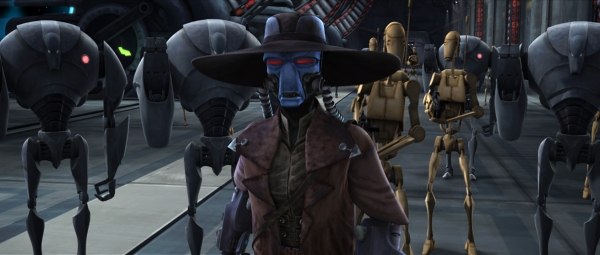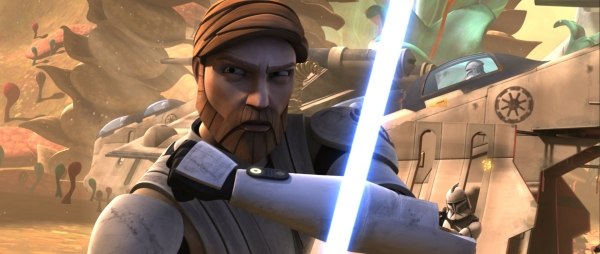The director of Star Wars: The Clone Wars discusses "Rise of the Bounty Hunters" and a host of new animated wrinkles in season two.
Check out the Clone Wars trailersand clips at AWNtv!
Season two of Star Wars: The Clone Wars kicks off tonight with a special one-hour premiere, "Rise of the Bounty Hunters," (8:00 p.m. on Cartoon Network), and we caught up with director Dave Filoni about the latest adventures of George Lucas' CG-animated series at Lucasfilm Animation. Merciless Bounty Hunter Cad Bane leads his droids to battle the Jedi, whose lives become more complicated and forbidden relationships are revealed.
Bill Desowitz: This second season introduces bounty hunters. What's the impact?
Dave Filoni:
Yeah, I'm really excited. Last season was about: What's this show? What's it going to be? What does it mean that it's CG? The audience now knows what it's about going in, but they're going to be surprised how much we've evolved the show, not just in the scenes and the stories, but also the animation itself and the way the show looks.
BD: And what's the story arc?
DF:
What the bounty hunter adds is sort of a third party. They're not the Separatists, they're not the Republic: they work for the highest bidder -- their morals are different. What they're trying to get out of the war and the chaos are different. I think it's interesting to assume that every bounty hunter would be a bad guy, but that's not necessarily the case. The bounty hunters can make choices. They're in the same kind of gray area as Han Solo. And you understood as a kid that there was this whole world of Greedo and Han and the cantina denizens that were different from the rebels or the Empire. And I think we really missed that in the first season. So we have that element and it's going to affect our main characters of Anakin and Ahsoka and Obi-Wan. When we get to Ahsoka, we're going to see her maturing process and her relationship with Anakin strengthen. And they act differently this season: she's not as snarky; she has to pay consequences for her actions, but she's smarter and she's more like Anakin. We see that Anakin cares more about her, which is part of Yoda's plan. And the big question is: Will Anakin learn that she is self-reliant and let her go?
Obi-Wan has a much more interesting arc in that we see that he's much more vulnerable. He's always been a very venerable Jedi Knight: always seeming on top of everything. We see a slightly more flawed Obi-Wan and we learn a bit more about his past and where he came from. So we get to go a bit more behind the beard, which I think a lot of fans have been wanting to see.
BD: Sounds richer. What about this adventure for you in CG animation?
DF: Well, this is the first show I'd ever done in CG. Coming from a 2D world for almost 10 years, I didn't know what to expect. You have a lot of fears about the Uncanny Valley. I was pretty excited by the initial renders we got back, and part of it was me maturing to what are the real possibilities here and listening to the people at ILM and talking with them and telling them my perspective coming from 2D and what I wanted to try and get on screen, and hearing their perspective coming from an amazing photorealistic world. I think that dialogue really started to get better and better as we got along in the series. You look at a lot of animation production and the increase in quality from the first season to the second and third seasons. After creating so much footage, you get an idea of what worked and what didn't.
BD: So what worked and what didn't?
DF:
Well, to me, right off the bat, when you look at the animation, a lot of the early commentary was about the wooden feel. People described it as a kind of Thunderbirds feel. I kind of knew going in that we were going to get that because o the angular, slightly edged style to the models. We weren't aiming for photorealism. But the style had to settle within itself once we had these models. And one of the problems with the models was the way they moved, and it had to do with the rigging. It's definitely not one of the more glorified jobs that people talk about but it's critical to the way the animators get the models to move and to have them express. We worked several times on the facial rig, just around the eyes and the nose and the brow to get them to wrinkle or flex or move better. And we started softening a lot of the harder edges that we had on the models. They're still there but they don't have to be so laser precise.
And I have a maquette sculptor, Darren Marshal, which is rare for television, and he sculpted a lot of initial clay maquettes that we based the models of the show on. And when you look them they look very precise, but when you put them under a microscope you see how really imprecise they are. But when you model in CG, of course, you can make these ridiculously perfect lines. And I think we also found that we wanted to vary things more with the models and make them more human. So you'll see an improvement in the quality of the animation as a result of the new rigs. Carl Sansonetti, my lead rigger, worked wonders communicating with the animators to address their needs and how to make the models better. So we fixed a lot of stuff on the fly last year and built some new ones.
BD: This is still in Maya?
DF: Yes, I believe Maya and the proprietary Lucas software that we always use. That's another benefit of our relationship with ILM and all their experience. My CG supervisor, Joel Aron, has been a staple at ILM a long time, and we started working on the show together last season on the episode "Trespass," when I wanted to introduce snow and have it look really interesting and function almost like a character. I showed him how we would've drawn snow or fire on Last Airbender and Joel has changed the way we do effects on Clone Wars. So around mid-season, you'll start to notice that the effects are more stylized and have more shape to them. It blends in with the character animation, which is also stylized.
BD: What's it been like for you using Zviz and how has that tool evolved?
DF:
When it first came about, I wasn't quite sure how it was going to work. As a storyboard artist, I said I could just draw these in half the time, but what happened was I bought into the concept. George wants to try this, so let's do it. We started talking with a team of developers behind the tool. And I think what they had never had before was a bunch of artists like me and my story guys who actually had to use it, so we started saying, "We don't need these functions here -- we don't need these buttons; we need very simply to pose the character." And then they would show us all of these more Maya-centric technical devices: a curve editor and cameras and lenses.
BD: Was it designed for more photoreal intentions?
DF:
That's part of it. The other thing was we were all such 2D storyboard artists and it was a real team effort to get this tool to work, and now I use it for all my functions, even for posing characters. I'll stick them under a lens and see how it affects the models as a reference tool. Once George taught me, I really learned to enjoy it, like blocking characters on a set and really shooting it like a film and now if I have a digital set, I just go shoot on it. And you can see a lot of leaps like that around the other studios, with Avatarcoming out and A Christmas Carol. We're just using this same kind of digital tool on a weekly basis and on a smaller scale.
BD: What is the latest iteration of Zviz able to offer you?
DF: I think for me a lot of it is interface-based: it's the ease of my interaction with the tool; how I can pose a character very quickly, now that we have a lot more automated poses. We have animation saved up that we can drop in and click. We worked out how to get the proxy models done faster and the sets faster, so what you've seen in the past is a lot of gray scale and we're trying to take it so that I have textures on everything. Now we can see the walls and the carpet and the floors and the trees and compose better and better shots with that. I imagine that I will get basic lighting set ups one day.
BD: How has the Singapore studio improved?
DF:
They've always been a really good group and the animation talent coming out of there always surprises me. I think, much like my crew here, they've seen their work released to the public and have watched final shots to see what works and doesn't. It's a lot easier to see it for some reason in clarity once it's done. But there have been a lot of people coming over from Lucasfilm Animation and ILM and mentoring these young people. And they have been very good at communicating what their needs are. And the type of responsibilities they've done on Clone Wars -- key shots with key characters -- and will continue to do this season shows they've come a long, long way.
BD: And CGCG from Teipi?
DF: They brought a tremendous amount of experience about how to do a CG television show and they've done a bulk of work for us. We told them we want to make it better, we want to add certain things and they've improved the quality of their animation as well. I think it comes in part with everybody liking Star Wars that works on this show. They're really committed to making it better, every season.
Bill Desowitz is senior editor of AWN & VFXWorld.











